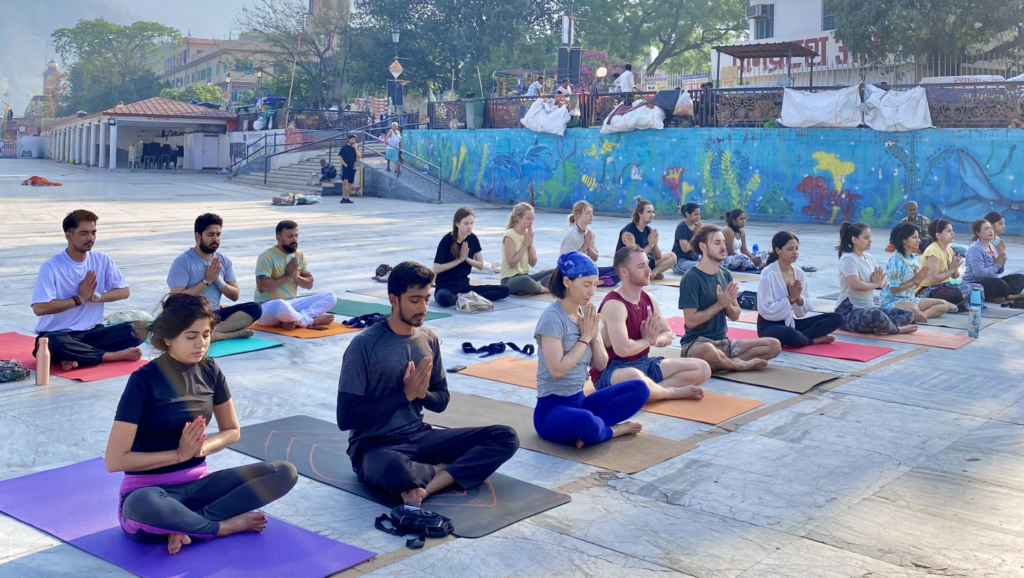We usually see yoga as a physical practice filled with different poses and breathing exercises. But did you know that repeating a word or sound mindfully is also a form of yoga? Chanting sacred sound vibrations is called mantra yoga, japa, or mantra meditation. This age-old practice is one of the most effective ways to clear your mind, sharpen your focus, and soothe your emotions. It’s simple yet powerful—easy to learn and requiring just 15 minutes a day.
What is a mantra?
A mantra is a word or series of words chanted aloud or silently to awaken spiritual qualities. The Sanskrit root “manas” means mind, and “tra” means tool—so a mantra is often called “an instrument for the mind” or “that which brings liberation when reflected upon.”
Mantras are sacred, mystical syllables first revealed to ancient sages (Rishis) in deep meditation. They’re among the earliest elements of yoga and possibly the first form of meditation ever developed. The most well-known mantra is “Om” or “Aum,” often used as the core of longer chants. These chants are usually in Sanskrit, Pali, Tibetan, or Prakrit, though sometimes in Hindi or Gujarati. While they’re believed to hold power for healing, protection, and prosperity, in mantra yoga, their main purpose is spiritual growth.
What is mantra yoga?
Mantra yoga is a meditation practice where sacred syllables are chanted along with mindful breathing to quiet the mind, awaken spiritual energy, and reach higher states of awareness. Chanting a mantra is one of the simplest yet most potent forms of meditation.
This practice is rooted in the science of sound vibration. Everything we do—our thoughts, words, actions, and emotions—is part of a larger energy field called prana, or life force. When we think or act, we send energy out into the world. Repeating a mantra directs that energy inward, helping us connect with our deeper selves and gain control over our minds.
In mantra yoga, the practitioner repeats a specific mantra to enter a meditative state. Focusing on the sound and meaning of these sacred words builds psychic energy, which can be used for spiritual growth and divine connection.
The power of pratyahara
By concentrating on sound vibrations, our attention turns inward, achieving the challenging state of pratyahara. When fully absorbed in the mantra, practitioners become completely present, unaware of their surroundings. This deep focus allows yogis to enter profound states of consciousness without outside distractions.
Practices of mantra yoga
The main techniques are japa (mindful mantra repetition), kirtan (call-and-response singing of mantras with music), and community chanting (often used in ceremonies or to open/close yoga sessions).
Types of chanting
- Vaikhari Japa – Chanting aloud to perfect pronunciation and feel the vibrations.
- Upamsu Japa – Whispering or humming softly for peace and harmony.
- Manasika Japa – Silent mental repetition, requiring intense focus. Ancient yogis say silent chanting is 100,000 times more powerful than speaking aloud.
Japa meditation technique
While learning from a mantra teacher is ideal, it’s not always easy to find one. Many offer classes, workshops, or online sessions. If practicing alone, fully understand the method before starting.
- Sit comfortably, eyes closed, and repeat the mantra silently or aloud.
- Focus on rhythm, pronunciation, and meaning. Let thoughts fade while breathing deeply.
- A mala (bead string) can help count 108 repetitions. Touching the beads enhances focus.
- If distracted, gently return to the mantra, breath, and beads.
- Ideally, finish after completing 108 cycles.
Kirtan meditation technique
Kirtan pairs mantras with music, deepening their impact. Choose uplifting songs with positive lyrics, a strong beat, and a simple melody—something that makes you feel joyful.
Benefits of mantra yoga
Like prayer and affirmations, mantra repetition powerfully affects the mind, body, and spirit. It:
- Boosts concentration, memory, and focus.
- Lowers heart rate, reduces blood pressure, and triggers relaxation.
- Builds confidence, reduces stress, and balances emotions.
- Dissolves negative karma, cultivates wisdom, and aids self-realization.
Daily practice maximizes benefits.
Practice tips
- Feel the mantra’s resonance in your body.
- Notice where vibrations settle (head, chest, etc.).
- Let the mantra flow naturally—don’t force it.
- If distracted, gently refocus.
- Start with short, simple mantras; progress to longer ones like the Gayatri mantra.
- Begin with 3–5 minutes daily, gradually increasing time.
- Best times: early morning or evening.
- Link breath and mantra for deeper focus.
- After chanting, reflect on the mantra’s meaning and effects.
Conclusion
Mantras serve many purposes—healing, meditation, growth, and prayer. By syncing breath with sound vibrations, they quiet the mind, dissolve negativity, and connect you to your higher self. These sacred chants calm the spirit and influence the body’s energy channels. Through regular practice, we tap into inner wisdom, live more mindfully, and foster personal transformation. Mantra yoga awakens inner consciousness, links us to the divine, and paves the way to spiritual enlightenment.
